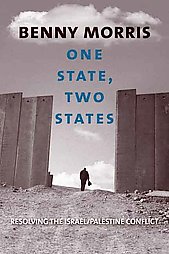|
Reviewed by Benjamin T. Acosta, Ph.D. Candidate, Claremont Graduate University In Israel, Benny Morris wears two hats. As the pioneer of the New Historian movement, Morris has produced a plethora of scholarly books and articles that have reshaped the boundaries of the Zionist-Arab conflict’s historiography. Indeed, Morris became the first Israeli historian to accurately show the good, the bad, and the ugly sides of Israel’s establishment in 1948. Never apologetic or compromising for either side of the Conflict, Morris’s scholarly work presents history with an unmatchable objectivity, which over the years has surely ruffled many feathers. As a political commentator, Morris’s journey seems as tortuous as that of the Israeli-Palestinian conflict itself. A former paratrooper turned peace activist and refusenik, Morris’s op-ed pieces have circulated with much interest since his apparent “neoconservative” conversion amid the Palestinians’ al-Aqsa intifada, which brought about the daily dread of suicide bombers. Uniquely, however, Morris has successfully maintained a separation of the distinct positions he holds within Israeli society. One State, Two States marks a long-awaited synthesis of the two Benny Morrises—scholar and political commentator. The convergence runs smoothly, and allows Morris to step outside of his usual historian style of rich description and offer a lighter, though equally thorough, writing performance. Morris cleverly divides the book into three sections: one on the latest “blather” of a one-state solution, the second on the history of solutions, and the third on his own prescriptions for a practical peace solution. First and foremost, One State, Two States is an exposé on proposed resolutions to the Israeli-Palestinian conflict but its narrating backdrop calls attention to the “steadfast” consistency of Arab rejectionism. Morris shows how the Arab side has always viewed solutions to the conflict within the framework of a zero-sum game. Thus, whether under the leadership of Hajj Amin al-Husseini, Yasser Arafat, or Mahmoud Abbas, the Arabs of Palestine/Palestinians have never truly committed to peace via either a binational state or a two-state fix. Morris finds the “word games” of Palestinian leaders saying one thing to Western audiences and another to their domestic constituency to epitomize the “duplicitous advocacy” of a two-state solution. Further, Morris is one of a few scholars on the Israeli-Palestinian conflict that rightly acknowledges the dominant role of Islam in Palestinian society and politics. Going back to the 1920s, the Arabs of Mandatory Palestine framed their conflict with Zionists in the “language of jihad,” and 90 years later, little has changed. Morris quips: “Only fools and children were persuaded in 2006-2007 that Hamas beat Fatah merely because [it] had an uncorrupt image… [The] main reasons for the Hamas victory were religious and political.” Ever the agitator, Morris boldly names the names of charlatans. That is, Morris exposes Palestinian propagandists masquerading as scholars. Notably, Columbia University professor and Barack Obama confidant, Rashid Khalidi comes under the gun. While brash, Morris treats those he criticizes with an appropriate sarcasm and humor. Morris gives Khalidi credit for at least being “admittedly cagey” with his book The Iron Cage. In refutation of Khalidi’s claim, as well as many others, that the Palestine National Council amended its charter and endorsed the goal of a “secular, democratic Palestine,” Morris simply responds: “This is hogwash.” Similarly, Morris notes: “Hamas is deadly serious (I don’t remember a Hamas leader ever cracking a joke)…” Morris calls it like he sees it, but importantly he backs up his brazen editorial reactions with the soundest of scholarly responses. While Morris seamlessly tailors a scholarly and politically active book, One State, Two States does contain a couple historical inaccuracies. Morris incorrectly states that Palestinians “inaugurated” suicide-terror attacks after Baruch Goldstein’s attack on Palestinians at the Tomb of the Patriarchs in Hebron in 1994. In actuality, Hamas and Palestinian Islamic Jihad launched a combined eight suicide-terror attacks in 1993, and the organizations adopted the concept of the suicide bomber as a shahid (martyr) in 1986 and 1989 respectively. Also, Morris marks Ariel Sharon’s visit on September 28, 2000 to the Temple Mount as the catalyst that sparked al-Aqsa intifada, disregarding the fact that Fatah had coordinated the onset of the Palestinian uprising after the failure of the Camp David talks a month earlier. Nevertheless, for anyone engaged in the daily-ups-and-downs of the peace process industry, One State, Two States is a must-read. Morris traces the history of solutions to the Israeli-Palestinian conflict and projects their potential trajectories—none of which paint a pretty picture for those that view a two-state solution as the only option. With “the historic will of the Palestinian national movement [remaining] bent on having all of Palestine,” peace continues down an intractable path. Though, basing his prescriptions on a fusion of historical precedents and current practicalities, Morris identifies a single “logical—and possible—way forward” that looks to an expanded Jordanian-Palestinian state. While Morris offers little assurance that his proposed Jordanian-Palestinian state could work, One State, Two States details the history of why all other proposed solutions lack any viability. |


 One State, Two States: Resolving the Israel/Palestine Conflict
One State, Two States: Resolving the Israel/Palestine Conflict 